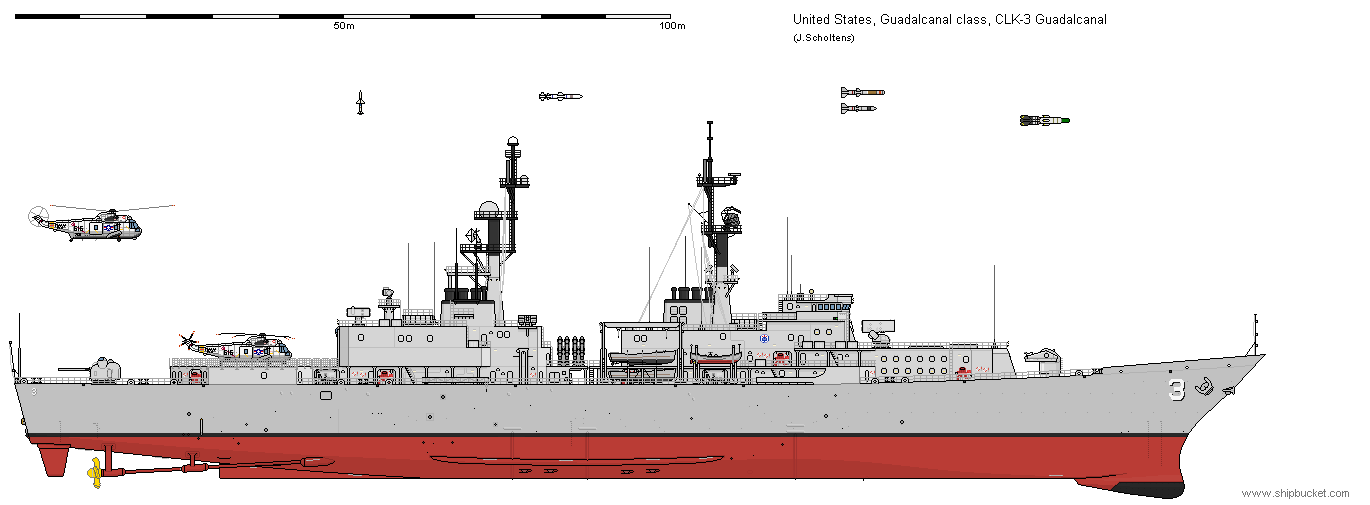Difference between revisions of "US Navy Connected ASW Fleet Ship Designs"
Acelanceloet (talk | contribs) (Created page with "''Note by author: This isn't a real concept, and isn't fact checked at all. It is however an interesting idea that probably never happened for some good reasons..... but that...") |
(No difference)
|
Revision as of 18:08, 14 November 2021
Note by author: This isn't a real concept, and isn't fact checked at all. It is however an interesting idea that probably never happened for some good reasons..... but that is never a reason not to check the implications of it! So, take it with a grain of salt ;)
Contents
The problem
In the late 1960’s, the US Navy had a problem. They had started development and construction on the DX, to be known as the Spruance class, and these ships had the potential to be the best ASW ships that could be made at the time. Why was this a problem, you ask? Because with the capabilities and the numbers of Soviet submarines, the USN needed more of these ships then they could ever afford.
Anti-submarine warfare is most of the time limited by detection of the enemy submarine. It is a lot easier to get close to your target under water without being detected then it would be on the surface or in the air. This is mostly because even with powerful sonars it is impossible to reach ranges similar to what radar can achieve. Because of this, the expensive AAW missile ships can be found closer to the centre of any large formation then the ASW ships, which have to be further out to detect submarines in time.
This is a problem, when the ASW ships you want are relatively close to the cost of the AAW ships, while you need many more of them to form an effective shield around your formation. The FRAM ships had reached the end of their careers, being no longer considered effective, and the threat analysis suggests that the best ships to replace them with would be a ship that at least weapons and electronics wise would be equal to a Spruance. Quite the opposite of what the USN would realistically want: keep a smaller ‘peacetime navy’ that could be upgraded by adding wartime emergency construction/rebuild ships. This would free the Spruance class for conversion to DXG.
Connected ASW Fleet
To achieve this, a new strategy was needed. And with the development of the systems for the Spruance class, the cause of the issue, the solution was found as well: the Connected ASW Fleet.
The connected ASW fleet concept depends highly on datalinks, the core of which is formed by the NTDS (Naval Tactical Data System). This system allowed ships CIC’s to share information with each other in real time so a single unified map of the battlespace was available from the data from every sensor. This allowed for more effective IFF, targeting and command. The Spruance class all had NTDS at the core of their electronic systems, which was one of the drivers for the ships large size.
The concept
The connected ASW fleet concept took this one step further. If you could share data, could you also distribute tasks? Did every ship need all systems to perform it’s mission, or could you centralise certain data? By 1970, a conceptual proposal had arisen.
- Towed arrays could be mass produced and had a relatively small ship impact. A containerised module could be build that could be put on wartime emergency ships or even on (modified) civilian ships.
- Datalinks became available that could handle large amount of data from relatively simple data acquisition systems, for example on containerised towed arrays.
- If ships could be operated cheaply enough, large numbers of towed arrays could be fielded using the above systems, allowing to ‘check’ a large area better then a smaller number of high cost ships could.
- If a small number of ships could gather, check and plot the data from small towed array ships and attack targets that appeared in this data, this would allow the USN to both protect convoys and hunt enemy submarines.
- If such a ship would be able to attack from beyond the submarines detection range, it could also act as deterrent, because any ship that COULD have a towed array would be a potential threat.
Reactions
The study initially wasn't a great success, but after the results were published, the navy felt it couldn't ignore it, as the potential was very high, IF it worked. The fact was, the abilities it promised could otherwise only be achieved by large numbers of aerial ASW assets. To judge its potential and cost-effectiveness, the navy started researching the baseline ships required for the Connected ASW Fleet concept. In 1971, the study was complete, and it was found that the resulting abilities were definitely worth it!
So, in 1973, congress authorised 4 brand new CLK's, 6 containerised towed arrays and 2 'wartime emergency prototypes'
The ships
CLK-3 Guadalcanal class
 The Guadalcanal class were the centerpiece of the Connected ASW Fleet. Carrying a flag plot, command staff, a layered ASW attack system and various datalink and communication systems
The Guadalcanal class were the centerpiece of the Connected ASW Fleet. Carrying a flag plot, command staff, a layered ASW attack system and various datalink and communication systems